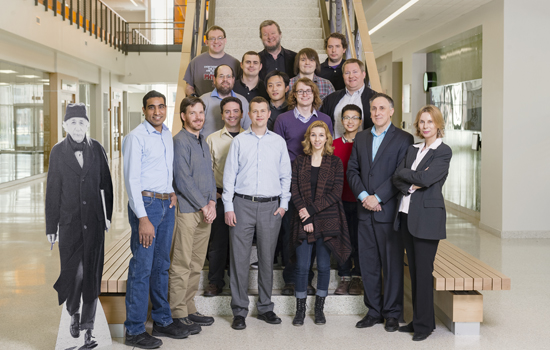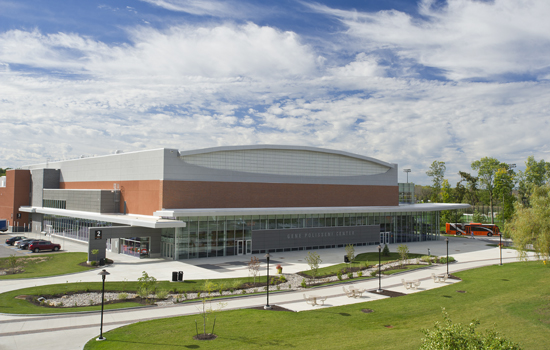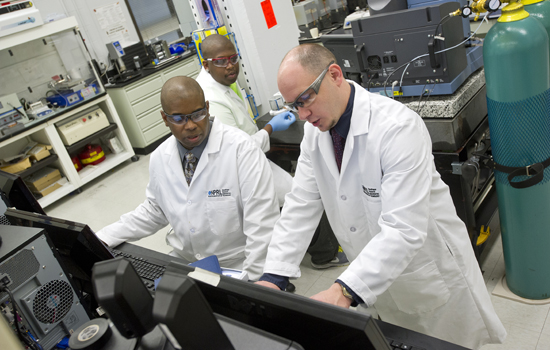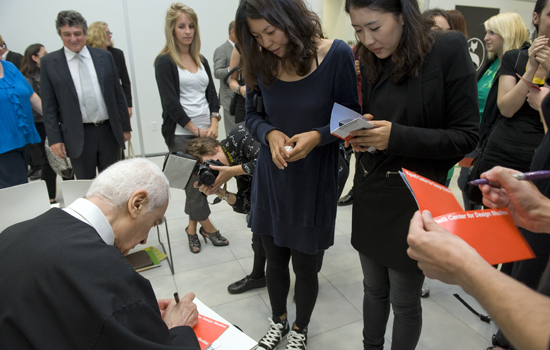Milestones under the leadership of Destler
2010: The iconic work of international designers Massimo and Lella Vignelli is permanently archived at RIT in a new design center, the Vignelli Center for Design Studies.
Christine Whitman, chair of the RIT Board of Trustees, said RIT President William Destler has positioned the university well for the future and that growth will continue as the 2015-2025 strategic plan is deployed.
“Dr. Destler’s legacy is firmly established as RIT has prospered under his steadfast leadership,” said Whitman. “The number of milestone achievements under his watch is outstanding. I would also like to thank Dr. Rebecca Johnson for her devotion and passion to RIT. She has been a dedicated ambassador for the university. She has been involved with initiatives such as the Rochester City Scholars Program, the Multicultural Center for Academic Success, as well as leading the Gandhi Institute for Nonviolence. Together, Bill and Rebecca have made a tremendous impact on RIT and the greater Rochester community.”
Here is a sample of Destler’s milestone achievements:
2008
- RIT opens a campus in Dubai, United Arab Emirates. Funded by the Dubai government, RIT Dubai is part of Dubai Silicon Oasis. RIT provides academic content, leadership and management of the university.
- The first Imagine RIT: Innovation and Creativity Festival draws more than 15,000 visitors to campus to see interactive exhibits and displays, including new ideas for products and services, creative arts and crafts, and faculty and student research.
- RIT opens its first “green” building, the new College of Applied Science and Technology. The $10.5 million, 33,600-square-foot facility earned the U.S. Green Building Council’s Gold Leadership in Energy and Environmental Design, commonly called LEED, certification.
- The College of Science launches a doctoral degree program in astrophysical sciences and technology.
- RIT and Rochester Regional Health begin a strategic alliance.
- The Golisano Institute for Sustainability creates the world’s first Ph.D. program focused on sustainable production. The program seeks to advance research and education in alternative energy development, sustainable design, green product development, industrial ecology and pollution prevention.
2009
- The University Services Center, which includes the glass-enclosed, circular Center for Student Innovation, opens. The 54,000-square-foot facility is the first building in Monroe County to be certified LEED Platinum by the U.S. Green Building Council.
- Saunders College of Business launches an online Executive MBA program. The 72-week program is identical to the curriculum taught on campus and includes an international trip for students to explore the global influence of business.
2010
- The men’s hockey team catapults into the national spotlight by earning a trip to the NCAA’s prestigious Frozen Four. The team’s surprising success (a program with no athletic scholarships and only Division I for five years) brings new pride to Tiger fans across the globe.
- Global Village, RIT’s $57 million international-themed retail and residential complex, officially opens. The project takes the shape of a European courtyard complete with an international market, Mexican cantina and fresh sushi bar.
- The iconic work of international designers Massimo and Lella Vignelli is permanently archived at RIT in a new design center, the Vignelli Center for Design Studies. The Vignellis created the New York City subway signage, the Handkerchief Chair, corporate identity programs for Xerox and American Airlines and packaging programs for Bloomingdales and Saks Fifth Avenue, to name a few.
2011
- The university breaks ground on a state-of-the-art “green” facility for its Golisano Institute for Sustainability. The building, which was dedicated in 2013, serves as a center for sustainability research, technology transfer, education and outreach and provides a showcase for green construction and design. The building was certified LEED Platinum in 2014.
- The College of Health Sciences and Technology—RIT’s ninth college—opens.
- Gerard Buckley ’78 (social work) becomes NTID’s first graduate to serve as its president on Jan. 1, 2011. He is the sixth head of NTID and the third deaf individual in this leadership role.
- B. Thomas Golisano College of Computing and Information Sciences unveils the School of Interactive Games and Media to foster continued growth of popular undergraduate and graduate programs in game design and development.
- RIT moves its Division III Intercollegiate Athletics program from the Empire 8 Conference to the Liberty League.
- RIT holds the world’s largest dodgeball game on May 1, 2011, with 2,136 players, beating the previous Guinness World Record of 2,012 set by the University of Alberta, Canada.
- RIT opens a second branch of its RIT Croatia in the capital city of Zagreb. The new campus joins the college’s existing campus in Dubrovnik.
- Institute Hall, which houses programs in biomedical and chemical engineering, opens. The building is the final element of a quadrangle located on the northwest side of the campus.
2012
- The women’s hockey team wins the Division III NCAA national championship and also announces it will move up to the Division I level.
- RIT announces it will contribute to the resurgence of the city of Rochester with a new Center for Urban Entrepreneurship located in the heart of downtown. A historical landmark building, the former Rochester Savings Bank, donated to RIT will serve as the home of the new center.
- The Carnegie Foundation names Professor Todd Pagano, who teaches chemistry in the National Technical Institute for the Deaf, U.S. Professor of the Year.
- RIT is among the first universities to create a department dedicated to computing security.
- RIT’s cooperative education program, which kicked off in 1912 with 32 students, turns 100 years old.
- RIT becomes home to New York State’s Center of Excellence in Sustainable Manufacturing. The center enables expanded research and technology transfer activity between industry and RIT.
- RIT launches the Innovative Learning Institute to position RIT to lead in the e-learning space.
2013
- RIT converts from the quarter academic calendar to the semester academic calendar.
- Golisano Institute for Sustainability, which houses one of the world’s first Ph.D. programs in sustainability, opens its doors to a new home. The institute conducts cutting-edge research in nanotechnology, alternative energy development and sustainable design. It is one of the greenest buildings in the world, powered by the sun, wind and fuel cell technology.
- Sebastian and Lenore Rosica Hall opens at NTID. This space serves as an innovation and research hub for NTID.
- The Kate Gleason College of Engineering graduates its first class of chemical engineering students.
- RIT partners with Uncommon Schools to develop a charter high school.
- RIT creates the Center for Media, Arts, Games, Interaction and Creativity (MAGIC), a research center devoted to the field of digital media. The center bridges the gap between university research and commercial production.
2014
- The Gene Polisseni Center, home to men’s and women’s hockey, opens with a roar. The $38 million ice arena has capacity for 4,300 Tiger fans.
- RIT launches its seventh doctoral program, a Ph.D. in engineering.
- RIT graduates its first class of Rochester City Scholars. Rochester City Scholars are Rochester City School District graduates who meet certain requirements and receive free full tuition to RIT. The first cohort started classes in the fall of 2010.
2015
- RIT launches the 2015-2025 strategic plan “Greatness Through Difference.” For the first time in RIT history, the word “research” is incorporated into the vision statement.
- RIT takes another step toward carbon neutrality by opening a massive 2-megawatt solar energy farm consisting of 6,138 photovoltaic panels used to generate electricity from the sun.
- RIT continues its successful academic exchange in China through an international partnership with Beijing Jiaotong University (BJTU). Two new degree programs begin in a joint collaboration between RIT’s Saunders College of Business and BJTU’s School of Economics and Management.
- MAGIC Spell Studios, a university program that will link RIT’s internationally ranked academic programs with high-tech facilities needed to commercialize computer gaming, film and animation, graphic design and imaging science projects, is created.
- The College of Health Sciences and Technology opens the Clinical Health Sciences Center, a 45,000-square-foot addition at the north end of Louise Slaughter Hall. The addition includes the Wegmans School of Health and Nutrition and Rochester Regional Health Family Medicine, a primary care office for RIT faculty, staff, dependents and the community.
- RIT announces plans to create its first Alumni House on campus, which will serve as a welcome center for graduates when it opens in 2017.
- For the second time in 10 Division I seasons, the men’s hockey team advances to the 2015 NCAA Tournament, winning the Atlantic Hockey Conference Championship.
2016
- Six RIT researchers are among the authors of a paper announcing what may be the most important scientific discovery in a century—findings that confirm the existence of gravitational waves predicted in Albert Einstein’s general theory of relativity.
- RIT is considered a “doctoral university” by the leading national classification of U.S. colleges and universities — The Carnegie Classification of Institutions of Higher Education.
- The men’s hockey team wins the Atlantic Hockey Championship and goes to the NCAA Tournament for the second straight year and third time as a Division 1 program.
- A consortium of universities and corporations led by RIT is chosen to receive a state grant to establish a New York State Center for Advanced Technology in Additive Manufacturing and Functional Printing.
- Five of RIT’s nine colleges have female deans as of July 1—Kate Gleason College of Engineering, College of Imaging Arts and Sciences, Saunders College of Business, B. Thomas Golisano College of Computing and Information Sciences and the College of Science.
 2016: The men’s hockey team wins the Atlantic Hockey Championship and goes to the NCAA Tournament for the second straight year and third time as a Division 1 program.
2016: The men’s hockey team wins the Atlantic Hockey Championship and goes to the NCAA Tournament for the second straight year and third time as a Division 1 program. 2011: The university breaks ground on a state-of-the-art “green” facility for its Golisano Institute for Sustainability. The building, which was dedicated in 2013, serves as a center for sustainability research, technology transfer, education and outreach and provides a showcase for green construction and design. The building was certified LEED Platinum in 2014.
2011: The university breaks ground on a state-of-the-art “green” facility for its Golisano Institute for Sustainability. The building, which was dedicated in 2013, serves as a center for sustainability research, technology transfer, education and outreach and provides a showcase for green construction and design. The building was certified LEED Platinum in 2014. 2016: Six RIT researchers are among the authors of a paper announcing what may be the most important scientific discovery in a century—findings that confirm the existence of gravitational waves predicted in Albert Einstein’s general theory of relativity.
2016: Six RIT researchers are among the authors of a paper announcing what may be the most important scientific discovery in a century—findings that confirm the existence of gravitational waves predicted in Albert Einstein’s general theory of relativity. 2010: Global Village, RIT’s $57 million international-themed retail and residential complex, officially opens. The project takes the shape of a European courtyard complete with an international market, Mexican cantina and fresh sushi bar.
2010: Global Village, RIT’s $57 million international-themed retail and residential complex, officially opens. The project takes the shape of a European courtyard complete with an international market, Mexican cantina and fresh sushi bar. 2008: RIT opens a campus in Dubai, United Arab Emirates. Funded by the Dubai government, RIT Dubai is part of Dubai Silicon Oasis. RIT provides academic content, leadership and management of the university.
2008: RIT opens a campus in Dubai, United Arab Emirates. Funded by the Dubai government, RIT Dubai is part of Dubai Silicon Oasis. RIT provides academic content, leadership and management of the university. 2015: RIT takes another step toward carbon neutrality by opening a massive 2-megawatt solar energy farm consisting of 6,138 photovoltaic panels used to generate electricity from the sun.
2015: RIT takes another step toward carbon neutrality by opening a massive 2-megawatt solar energy farm consisting of 6,138 photovoltaic panels used to generate electricity from the sun. 2012: The women’s hockey team wins the Division III NCAA national championship and also announces it will move up to the Division I level.
2012: The women’s hockey team wins the Division III NCAA national championship and also announces it will move up to the Division I level. 2014: The Gene Polisseni Center, home to men’s and women’s hockey, opens with a roar. The $38 million ice arena has capacity for 4,300 Tiger fans.
2014: The Gene Polisseni Center, home to men’s and women’s hockey, opens with a roar. The $38 million ice arena has capacity for 4,300 Tiger fans. 2011: Institute Hall, which houses programs in biomedical and chemical engineering, opens. The building is the final element of a quadrangle located on the northwest side of the campus.
2011: Institute Hall, which houses programs in biomedical and chemical engineering, opens. The building is the final element of a quadrangle located on the northwest side of the campus.









